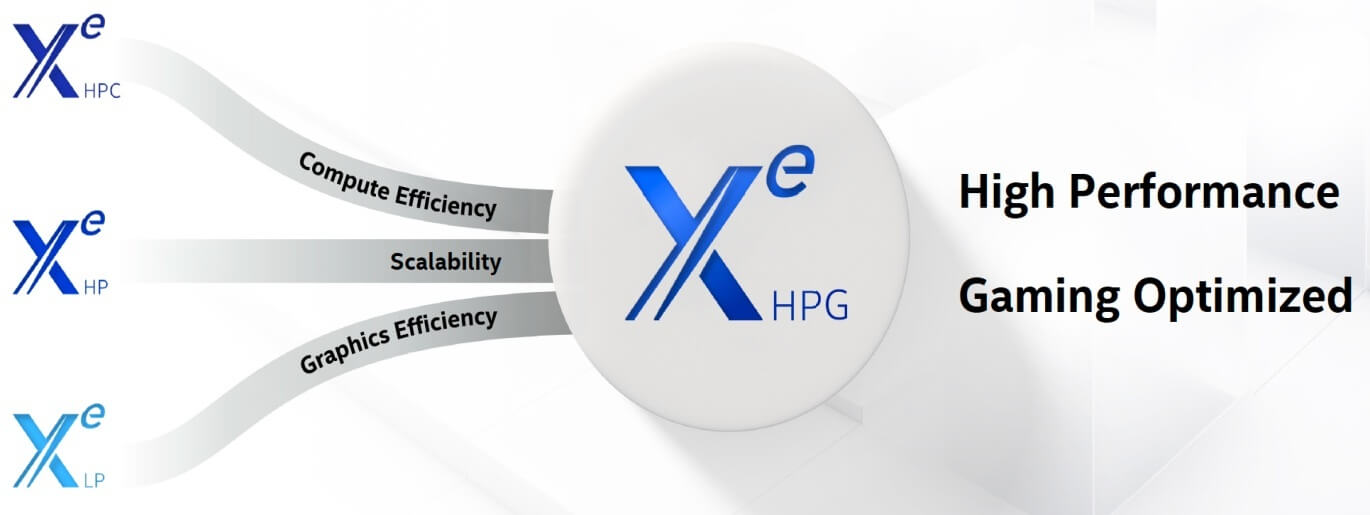We can all agree that we seriously need a third discrete GPU competitor in the market. AMD and NVIDIA have already dominated the discrete gaming GPU market since long, and now INTEL plans to enter the competition to capture some market share and goodwill.
Some leaked specifications of Intel’s upcoming Xe-HPG (High-Performance Gaming) graphics cards have been shared recently by twitter user @harukaze5719. The spec details are more or less in line with the previously leaked data and rumors, but we do have some more technical info to share.
Just to recap some main points before going into the GPU spec details, back in October 2020, Intel taped out its first discrete Gaming GPU, the Xe-HPG ‘DG2’ graphics processor.
The company reaffirmed that it is working on a full stack of discrete Xe-HPG-based GPUs that will target the mid-range/mainstream, and also the enthusiast gaming market segment sometime later this year.
The new Intel DG2 discrete gaming graphics processor was in “alpha silicon” form back then, but Intel said they’ve already powered-on this new DG2-based GPU in their labs. DG2 isn’t just a successor to DG1, but instead is a higher performing bracket GPU based on the company’s latest Xe-HPG architecture.
Xe-HPG is the enthusiast, and gaming focused GPU architecture, incorporating hardware-enabled features found in similar discrete GPUs from AMD and NVIDIA like e.g. ray tracing/RTX etc.
Intel’s family of Xe-HPG graphics processors will consist of multiple SKUs targeting different market segments spanning all the way from mid-range to the high-end enthusiast level.
Coming to the specs, first up we have the entry-level SKU starting with just 96 EUs or 768 shaders/SPs and 4GB VRAM buffer, slapped on a low 64-bit wide memory bus. This low end entry-level discrete GPU will most likely compete with similar offerings from AMD and Nvidia.
On the highest-end of the GPU stack, we have the top SKU which sports 512 EUs, which amounts to 4,096 shader processors/SPs, and the GPU is expected to feature either 8 or 16GB GDDR6 memory frame buffer tied on a 256-bit wide memory bus.
This top flagship SKU will likely compete with similar high-end GPUs from both AMD and Nvidia.
The next GPU model just below the 512 EU part features 384 EUs or 3,072 cores in total, tied on a 192-bit bus paired with either 6 or 12GB of GDDR6 VRAM. Based on speculation, this SKU is most likely going to compete with the AMD’s RX 6700 series of cards, and Nvidia’s RTX 3060/Ti series, or even the rumored RTX 3050/Ti GPU.
Coming to the next SKU, further down the stack we have a 256 EU GPU model sporting 2,048 cores, and a 192 EU part with 1,536 cores. The 256 EU GPU model will sport either 4 or 8GB GDDR6 VRAM tied on a 128-bit bus.
The 192 EU part on the other hand is expected to feature only 4GB GDDR6 memory, once again tied on a 128-bit bus. Both of these SKUs are likely going to compete against the Radeon RX 6600 and the RTX 3050 series of cards (insert speculation here).
Finally, there is also a 128 EU part with 1024 SPs, once again tied on a weak 64-bit memory bus as the entry level 96 EU SKU. This card will also likely get 4GB of frame buffer/VRAM.
That was the full rumored lineup of XE-HPG GPUs; however, you should keep in mind that not all SKUs are going to hit retail shelves, as Intel’s roadmap might change as the launch gets closer. These might be early engineering samples/ES, and the final specs are subject to change as well.
Intel’s XE-HPG GPU lineup was already rumored to be manufactured outside of Intel’s fabs, in an external foundry. Back then while Intel didn’t mention which fab and process node was going to be used, but if this report from REUTERS is anything to go by, then they might tap TSMC’s enhanced 7nm process node.
Intel has actually used a lot of other third-party IP, such as the memory controller and interface, and display interface to optimize the overall design costs. Though, Intel hasn’t clarified whether DG2 is a flagship-grade bigger chip, or a more modest, and smaller high-volume part.
For now, the company is simply saying that DG2 will, “take our discrete graphics capability up the stack into the enthusiast segment.”
With its graphics chips, Intel is looking to tap into the booming PC gaming market. Its DG2 chip is expected to be released late this year or in early 2022 and will compete with Nvidia and AMD gaming chips that cost between $400 and $600.
The chip manufacturing technology for the DG2 is expected to be more advanced than the Samsung Electronics Co Ltd’s 8-nanometer process used in Nvidia’s most recent round of Ampere graphics chips, according to the same report as posted by Reuters.
They added it would also have a leg up on the Advanced Micro Devices’ graphics chips made on TSMC’s 7-nanometer process.
Intel’s senior Vice President, Raja Koduri, recently posted a teaser of the company’s first gaming discrete graphics cards on Twitter, the Xe HPG. Intel’s Xe HPG DG2 (High-Performance Gaming) gaming graphics card was tested in the new 3DMark Mesh Shader feature test by Intel.
Mesh Shader is one of the major features introduced within DirectX 12 Ultimate API back in 2020. The feature is supported by NVIDIA’s Turing, Ampere, and AMD’s RDNA 2 lineup of gaming cards.
Intel will also be adding Mesh Shaders support on its Xe-HPG discrete GPUs. Mesh Shaders give developers more programmability than ever before. By bringing the full power of generalized GPU compute to the geometry pipeline, mesh shaders allow developers to build more detailed and dynamic worlds than ever before.
Intel is expected to unveil its DG2-based graphics cards later this year. Though at the recent January 11 CES 2021 event, there was no mention of this discrete gaming GPU.
Stay tuned for more tech news!
Hello, my name is NICK Richardson. I’m an avid PC and tech fan since the good old days of RIVA TNT2, and 3DFX interactive “Voodoo” gaming cards. I love playing mostly First-person shooters, and I’m a die-hard fan of this FPS genre, since the good ‘old Doom and Wolfenstein days.
MUSIC has always been my passion/roots, but I started gaming “casually” when I was young on Nvidia’s GeForce3 series of cards. I’m by no means an avid or a hardcore gamer though, but I just love stuff related to the PC, Games, and technology in general. I’ve been involved with many indie Metal bands worldwide, and have helped them promote their albums in record labels. I’m a very broad-minded down to earth guy. MUSIC is my inner expression, and soul.
Contact: Email



